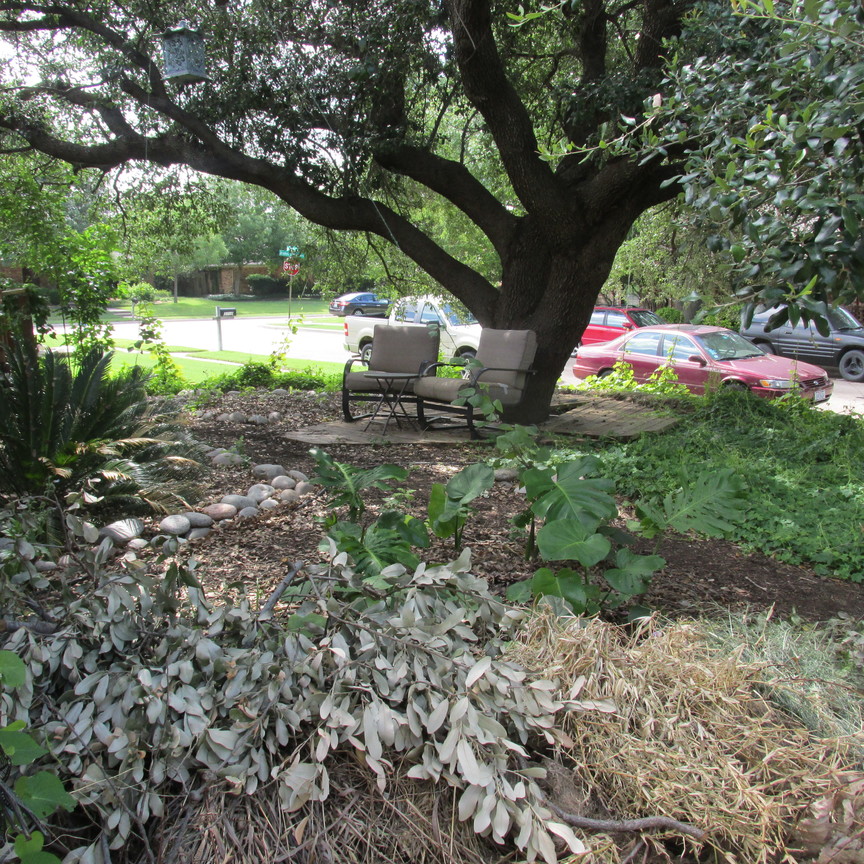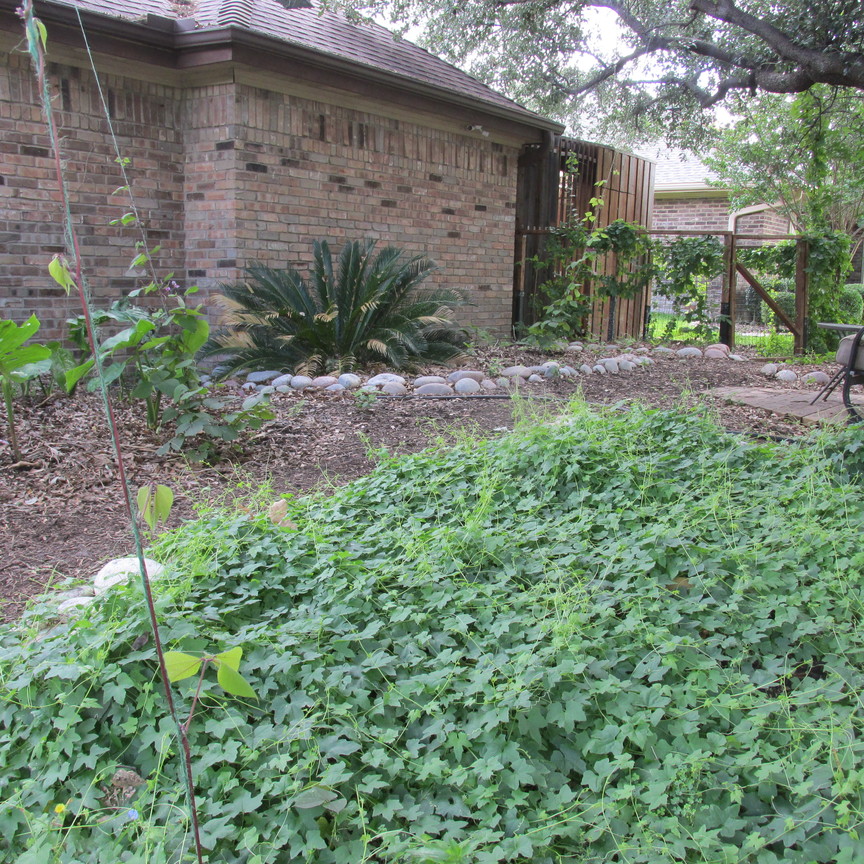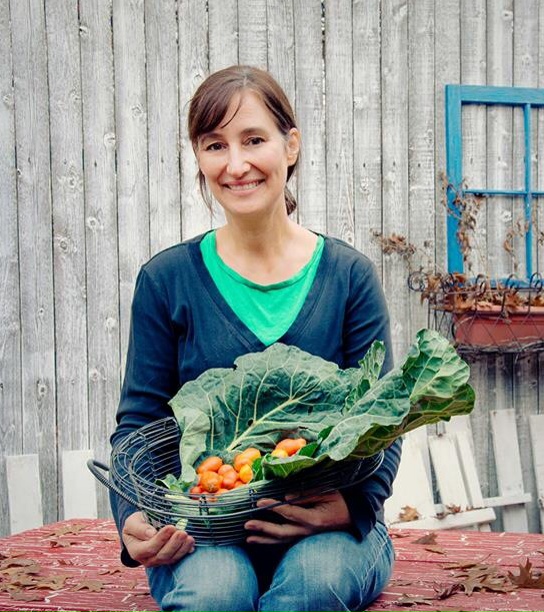Urban Permaculture:
Creating a Swale on an Urban-Sized Scale
By Anne-Marie Miller
If you have been listening to The Urban Farm Podcast you have probably heard a lot about permaculture. I have been listening to/reading about permaculture ideas so much it is hard for me to believe there is a person on the planet that doesn’t know about the concept. However, the other day I was reminded that there are those abnormal people that don’t find digging in the garden one of the greatest joys in life! I know! It is hard to imagine. Then there is another group of people that are so busy digging in the dirt that they don’t have time to research all these fun, useful techniques. Therefore, there could be those that have not yet been introduced to the fabulous concept of permaculture. I will try to quickly break it down for you.
Whenever I want to understand a word, I like to break it down and define it. The word permaculture started out by combining the two words “permanent” and “agriculture.” Continuing with that concept, I like to think of it as setting up your property so that it continually provides food without the back-breaking struggle to do so. It is full of concepts which allow the gardener to work with nature instead of against it. There have been so many concepts added to this way of gardening/farming that it would be impossible to encompass them all in one article. Therefore, I am going to deal with what I feel is one of the most important concepts of permaculture: water catchment.
Water catchment can be explained as using various techniques to keep the water, which would otherwise run off the property, in place to be utilized for nourishing the growing food.
One way to store water to use during dry times is in a rain barrel. Although I have several rain barrels on my property, I find there are a few drawbacks to this system. First, in the spring rains, that barrel fills fast! Problem is, it seems to empty just as quickly on my thirsty garden! Second, the gutter pipes and the netting to keep out debris get clogged. Regular maintenance is needed to keep the entire system flowing freely. By regular, I mean every time it rains! This constant maintenance seems contrary to permaculture concepts of making things easier for the farmer. Although I think water catchment in this way is good, there is a way I like a lot better: digging a swale.
A swale is basically a level ditch that catches the runoff water and keeps it on the property a bit longer. This allows the water to seep slowly into the surrounding earth, nourishing the plants around it. I have been on permaculture tours and noticed one thing: None of them, in my area at least, are done on urban property. I have only seen huge swales that stretch for miles and have been dug with heavy equipment. Everything must be scaled down on an urban lot, including the tools used to dig the swale. In my case it has been scaled down all the way to a shovel. I call it my permaculture workout. The people jogging by look at me like I am crazy. I ask you, “Who is the crazy one?” I mean, after all, people pay good money for this muscle building workout! I am so tempted to start one of those boot camp type workout groups in the parking lot across the street from my house. After I have finished barking out orders to do push-ups with bags of dirt on their backs we could all jog across the street and I could hand everyone a shovel. I would get my swale dug in record time and they would get good firm bodies. I think that is a good trade off.
The first step to creating my swale was to watch the water runoff on the property. There happens to be a V in the roof where the rain water comes down in torrents, runs across the side walk, down the driveway and into the street. It has become my mission in life to redirect that water into my swale. I don’t have gutters on that side of the house, but if you did it would be easy to run flexible pipe to divert the water right into your swale.
My swale is on a slope so I am mounding up the earth on the downhill side of the ditch. I hope to be done by fall so I can sink a few fruit trees into this mound. I also have comfrey starts all ready to plant there. Rabbits love comfrey and I love saving money on rabbit food. It will be a permaculture victory!
You might be saying, “I don’t want a ditch running across my yard.” Well hang on to your seat as I explain how water catchment can be both useful and beautiful.
I first found out how to make a swale beautiful when I met Lane. He was offering free fill dirt and I needed just that, to help a friend make raised garden beds. When I pulled up in front of his house it looked like a construction zone. His yard looked as if a huge mole had woven around his yard creating deep tunnels as it went. The dirt wasn’t being mounded up, but instead put into 5-gallon buckets to be carted off the property.
It all became clear when he showed me his side yard. He had made his swales into wide garden pathways lined decoratively with smooth river rocks. He explained that, by filling the swales/ditches with mulch, it allowed the rainwater collected from the house to seep into the pathways and stay on the property slowly seeping into the surrounding garden beds. The result was brilliant and beautiful! He had even made a lovely outdoor cathedral of sorts by stretching twine from the ground to the trees above and growing bean vines up them, making a wall of leaves. As I sat on the bench surrounded by greenery, with the sunlight streaming through, I thought, “Now this is urban permaculture at its best, urban style!” My friend Lane utilizes many other permaculture principles on his property. I am definitely recommending him for a podcast.
I hope I have inspired you to take a look at the way water runs off your property this spring. Give some thought to digging a swale, not only will you utilize the precious resource of water, but you can impress your friends with your permaculture brilliance and you might just lose those love handles in the process!




 Anne-Marie or Dash (for the hyphen in her name) is an urban farmer in Dallas, Texas. She raises chickens and rabbits on less than ¼ of an acre. Plus, she has turned her front yard into a large stand-out-in-the neighborhood vegetable garden. In addition to the farming she does on her homestead, she helped create a community garden literally from grassy field to thriving garden. What stands out about her little urban homestead is her determined out of the box approach to overcoming obstacles. You can follow her adventures on her little urban homestead by visiting her blog: BloomWhereYourPlanted.com.
Anne-Marie or Dash (for the hyphen in her name) is an urban farmer in Dallas, Texas. She raises chickens and rabbits on less than ¼ of an acre. Plus, she has turned her front yard into a large stand-out-in-the neighborhood vegetable garden. In addition to the farming she does on her homestead, she helped create a community garden literally from grassy field to thriving garden. What stands out about her little urban homestead is her determined out of the box approach to overcoming obstacles. You can follow her adventures on her little urban homestead by visiting her blog: BloomWhereYourPlanted.com.







What about mosquitos? Does a swale cause mosquitos? I live in San Antonio and we have major mosquito problems.
I’ve seen many swales filled with mulch/hay/grass and tree clippings…they absorb the water…would seem to fix that problem, I’d guess, unless there were flooding type conditions…
Can you publish pictures of your friends garden with It paths filled with smooth river rock?